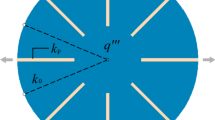Abstract
Heating coils utilize the concept of resistive heating to convert electrical energy into thermal energy. Uniform heating of the target area is the key performance indicator for heating coil design. Highly uniform distribution of temperature can be achieved by using a dense metal distribution in the area under consideration, however, this increases the cost of production significantly. A low-cost and efficient heating coil should have excellent temperature uniformity while having minimum metal consumption. In this work, space-filling fractal curves, such as Peano curve, Hilbert curve and Moore curve of various orders, have been studied as geometries for heating coils. In order to compare them in an effective way, the area of the geometries has been held constant at 30 mm × 30 mm and a constant power of 2 W has been maintained across all the geometries. Further, the thickness of the metal coils and their widths have been kept constant for all geometries. Finite Element Analysis (FEA) results show Hilbert and Moore curves of order-4, and Peano curve of order-3 outperform the typical double-spiral heater in terms of temperature uniformity and metal coil length.
Similar content being viewed by others
References
B. Curković, V. Vitulić, D. Babić-Naglić, and T. Dürrigl, Zeitschrift fur Rheumatologie 52, 289 (1993).
K. A. Sluka, M. R. Christy, W. L. Peterson, S. L. Rudd, and S. M. Troy, Arch. Phys. Med. Rehabil. 80, 313 (1999).
K. W. Hayes, Arthritis Rheum. 6, 156 (1993).
A. M. Hussain, E. B. Lizardo, G. A. Torres Sevilla, J. M. Nassar, and M. M. Hussain, Adv. Healthcare Mater. 4, 665 (2015).
J. F. Lehmann, Therapeutic Heat and Cold, (Williams & Wilkins 1990) pp. 153–154.
J. F. Lehmann, G. D. Brunner, and R. W. Stow, Arch. Phys. Med. Rehabil. 39, 560 (1958).
J. F. Lehmann, A. Masock, C. Warren, and J. Koblanski, Arch. Phys. Med. Rehabil. 51, 481 (1970).
J. W. Gersten, Am. J. Phys. Med. 34, 362 (1955).
Y. Mo, Y. Okawa, K. Inoue, and K. Natukawa, Sens. Actuators, A 100, 94 (2002).
R. Sharma and P. Khanna, Fuel 112, 550 (2013).
Q. Wan et al., Appl. Phys. Lett. 84, 3654 (2004).
T. Kim, Int. J. Hydrogen Energy, 36, 1404 (2011).
D. N. Pagonis, G. Kaltsas, and A. G. Nassiopoulou, J. Micromech. Microeng. 14, 793 (2004).
V. Balakrishnan, H.-P. Phan, T. Dinh, D. V. Dao, and N.-T. Nguyen, Sensors 17, 2061 (2017).
T. Neda, K. Nakamura, and T. Takumi, Sens. Actuators, A 54, 626 (1996).
C.-L. Dai, M.-C. Liu, F.-S. Chen, C.-C. Wu, and M.-W. Chang, Sens. Actuators, B 123, 896 (2007).
M. Weber, P. Lerch, and P. Renaud, J. Micromech. Microeng. 7, 210 (1997).
G. Liu et al., Microelectron. Eng. 129, 46 (2014).
R. Pimentel-Domínguez, P. Moreno-Álvarez, M. Hautefeuille, A. Chavarría, and J. Hernández-Cordero, Biomed. Opt. Express 7, 1138 (2016).
K. Visvanathan and Y. B. Gianchandani, in TRANSDUCERS 2009-2009 International Solid-State Sensors, Actuators and Microsystems Conference, (Denver, CO, USA, 2009), pp. 2421–2424.
Q. Zhou, A. Sussman, J. Chang, J. Dong, A. Zettl, and W. Mickelson, Sens. Actuators, A 223, 67 (2015).
W.-Y. Chang and Y.-S. Hsihe, Microelectron. Eng. 149, 25 (2016).
L. Mele et al., Procedia Eng. 25, 387 (2011).
T. Guan and R. Puers, Procedia Eng. 5, 1356 (2010).
M. Prasad, Microelectron. Reliab. 55, 937 (2015).
J. A. Fan et al., Nat. Commun. 5, 3266 (2014).
Author information
Authors and Affiliations
Corresponding author
Rights and permissions
About this article
Cite this article
Charan, K.K.S., Nagireddy, S.R., Bhattacharjee, S. et al. Design of Heating Coils Based on Space-Filling Fractal Curves for Highly Uniform Temperature Distribution. MRS Advances 5, 1007–1015 (2020). https://doi.org/10.1557/adv.2020.17
Published:
Issue Date:
DOI: https://doi.org/10.1557/adv.2020.17




